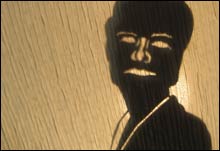Total recallSpacing out the act of memory November 29,
2006 6:05:16 PM

SHADOWS OF POSSIBILITY: Collusion of sculpture + acting.
|
If we could give memory feet, how might it approach? In a slow, drawn-out shuffle? With the soft thuds of a barefoot, leaping child? What might memory finger and hold, if we gave it hands, and if it had its own voice, with what rhythms and refrains might it murmur? Finally, in what sorts of rooms does memory move and linger? How might those spaces, lent objects and light, look to us?
Memory got physical manifestations of all of these things in Living History, a love-child of sculptural installation and theater, designed and directed by Jennie Hahn, and created and performed by Virginia Collins, Anna Korsen, and Christopher Reiling. This smart and lyrical cross-discipline work, which had its workshop premiere last week in the Neal Street Garage, shows how visual art and performance might foster more intimate relations. Living History ran for just one weekend, but I hope Portland will see more of its kind.
The theatric inhabitation of Hahn’s site was the culmination of a design phase by Hahn, and then a ten-day collaborative process with the ensemble, during which the performance developed alongside the evolving installation. During Hahn’s early sketches of the space, she realized her images had roots in her own personal history of family and the Maine landscape. When she came together with Collins, Korsen, and Reiling, everyone discussed their own takes on these themes, and finally realized what they were really talking about was memory. From this launching point, the ensemble went on to create the script, using stories and scraps of dialogue that emerged from free-writes and improv sessions. The result was an intermingling of their personal memories, which the actors both expressed and embodied.
The space that these memories explored was a place of grays, waves, and kelp, even as it held, at its center, books, an ancient radio, and furniture of warm wood — it was at once the Maine coast and a home remembered from childhood, simultaneously outdoors and indoors. Leading into the place was a series of sheer, pale fabric screens — reminiscent of the circuitous gray matter in our own heads — through which the ensemble wound its way. In corners and at the edges, Hahn had piled seaweed and sea-smoothed stones, and in the center, where the old-fashioned room sat in warm light, there were tall fronds of sky or sea. The fabric screens of the entrance held and diffused the installation’s low but concentrated light, like water and clouds, and built gradations of shadow against shadow. The space felt volatile despite its peace, as if the juxtaposition of these different elements and settings might trigger anything at all.
It did. We got Reiling entering on dinosaur feet, growling about how big they’ll think he is (Remember jumping in the sand or snow to make huge footprints, then poking out a few holes for toes around the top?). We got Collins’s memory of ambrosial childhood lemonade, and Korsen’s recollections of a drunken grandmother. “Did I ever crawl into that purse?” each performer refrained cryptically, like figments of echoes. “But inside was the booze,” went another repeated fragment. And: “I remember that.” Between these searching surges and retreats of language, the ensemble’s blocking was similarly wave-like — sometimes strong and fluent, sometimes playful, and sometimes cautious, eddying and whispering back upon themselves in uncertainty. Books slammed shut; stones were struck. And as we in the audience became accustomed to the rhythms of surge and retreat of both movement and language, the course of the performance slowly revealed hints of meaning surrounding these scraps of memory.
But like the detritus of seaweed and stone left behind by the tides, the recollections and words of the ensemble were tossed, returned, hodge-podged into new configurations. “So I have this so-called memory,” went another of their refrains, and toward the end we learned just how fragile and fickle remembrance can be. In simultaneous child-memory monologues by Collins and Korsen (spilling soup in a high chair, taking a bath) the tellers gradually began to borrow and exchange language and details. The adapted stories, far cries from the first versions we hear, illustrated a recollection’s effortless capacity to morph into something less (or more) than a “true” memory.
“I’ve got one like that,” each ensemble member said of such “memories,” as the stories and scraps of sense cycled through their rolls and wanes. Most of us do. In fact, in the echoes, pitter-patters, and hide-and-seek language of this ensemble, Hahn’s rich room sounded a lot like home.
Email the author
Megan Grumbling: mgrumbling@hotmail.com.
|
 |


|
- Meet Eric Fehrnstrom, Romney’s teeth-baring press secretary
- Why, in desperate times, we turn to lolcats, twee songs, and mute kittens
- Growing up in the Third Reich (a memoir)
- Never mind its tough-girl alt-porn feminism: SuicideGirls has already moved on to a new generation
- Barack offers America the best chance for a fresh start
- Linc Chafee exhibits typical candor in his forthcoming book
- Meet Eric Fehrnstrom, Romney’s teeth-baring press secretary
- Barack offers America the best chance for a fresh start
- Growing up in the Third Reich (a memoir)
- Why, in desperate times, we turn to lolcats, twee songs, and mute kittens
- Media watch
- Esserman imposes tougher standards, but some cops cite inconsistent discipline
|
-
The Theater Project's Winter Cabaret puts TV on the boards
-
Cape Elizabeth poet Jonathan Aldrich assembles the pieces
-
The longings of mistreated women cannot be Eclipsed
-
Acknowledging our privilege causes deep suffering
-
Lampooning the theater that is politics
-
A venue-to-venue tour of Portland
-
Preview 2008: the winter of malcontents
-
Portland theatre: 2007 in review
-
Kids have a lot to teach us about art
-
You'll want both eyes for Seacoast Rep's Christmas Story
|

|